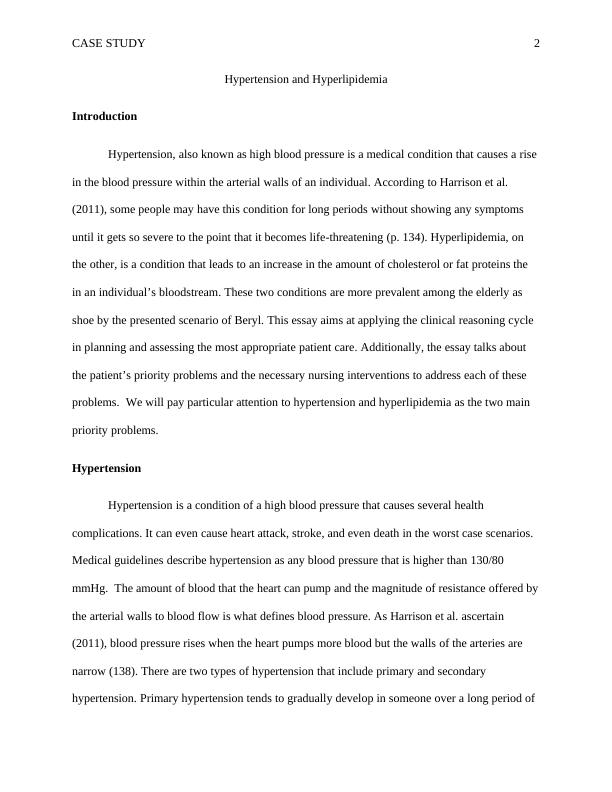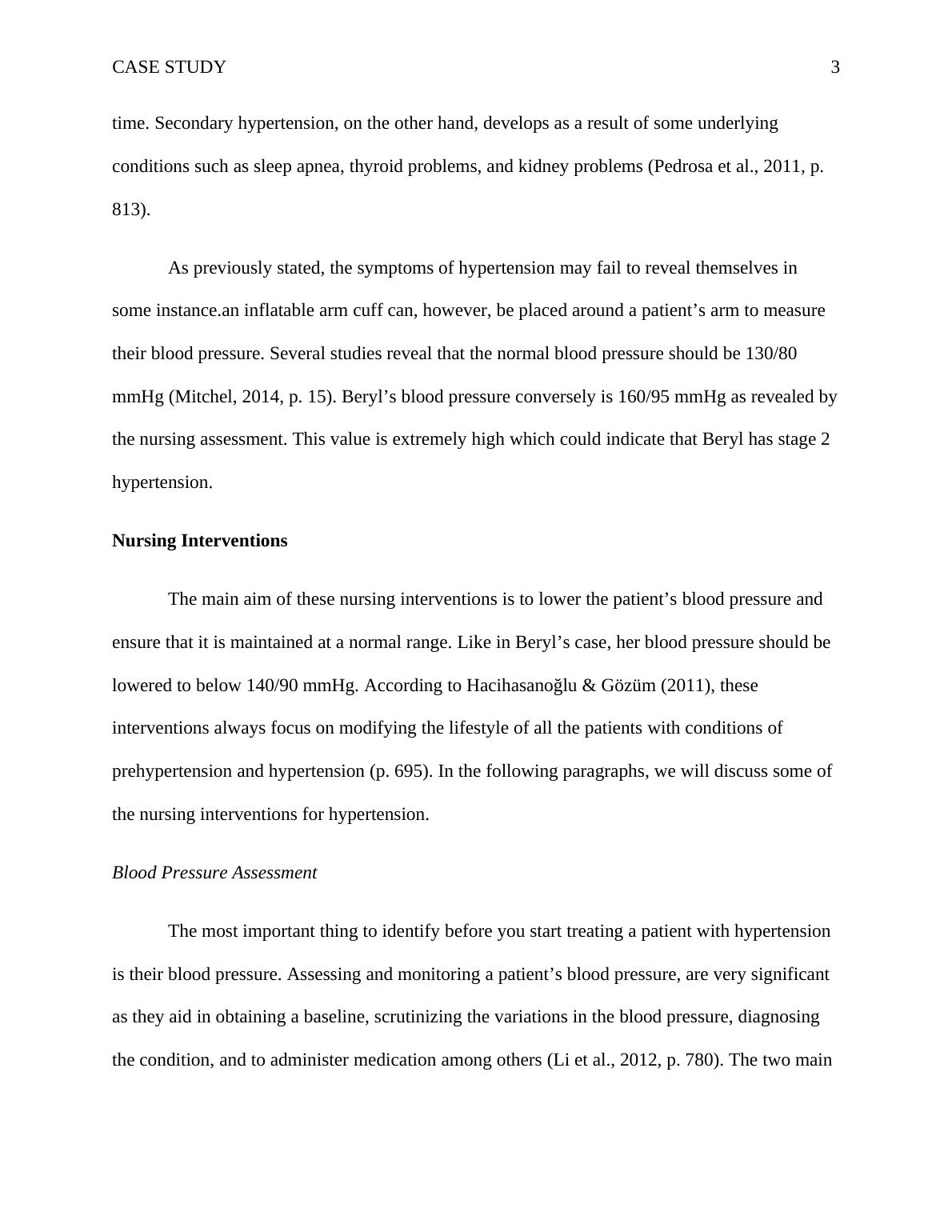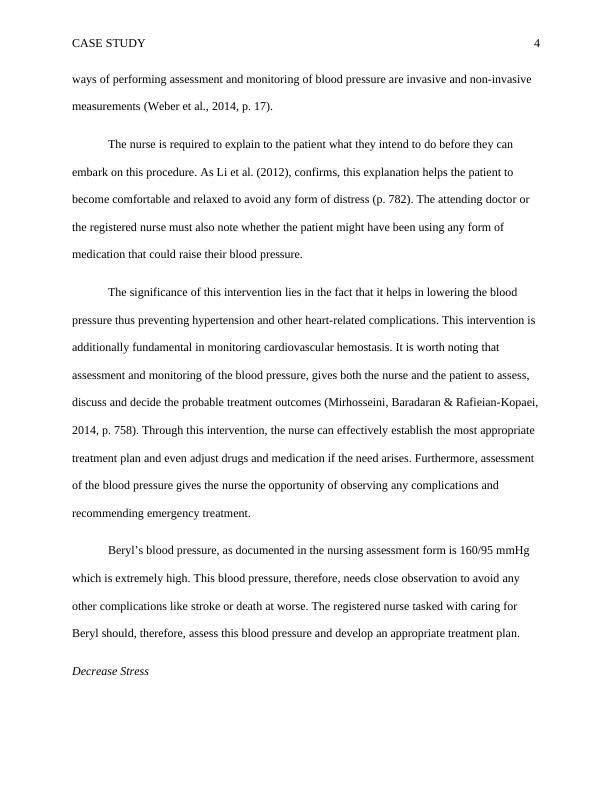Hypertension and Hyperlipidemia: Case Study
Added on 2021-06-16
12 Pages3624 Words161 Views
Running head: CASE STUDY1Case studyNameInstitution

CASE STUDY2Hypertension and HyperlipidemiaIntroductionHypertension, also known as high blood pressure is a medical condition that causes a rise in the blood pressure within the arterial walls of an individual. According to Harrison et al. (2011), some people may have this condition for long periods without showing any symptoms until it gets so severe to the point that it becomes life-threatening (p. 134). Hyperlipidemia, on the other, is a condition that leads to an increase in the amount of cholesterol or fat proteins the in an individual’s bloodstream. These two conditions are more prevalent among the elderly as shoe by the presented scenario of Beryl. This essay aims at applying the clinical reasoning cycle in planning and assessing the most appropriate patient care. Additionally, the essay talks about the patient’s priority problems and the necessary nursing interventions to address each of these problems. We will pay particular attention to hypertension and hyperlipidemia as the two main priority problems. HypertensionHypertension is a condition of a high blood pressure that causes several health complications. It can even cause heart attack, stroke, and even death in the worst case scenarios. Medical guidelines describe hypertension as any blood pressure that is higher than 130/80 mmHg. The amount of blood that the heart can pump and the magnitude of resistance offered bythe arterial walls to blood flow is what defines blood pressure. As Harrison et al. ascertain (2011), blood pressure rises when the heart pumps more blood but the walls of the arteries are narrow (138). There are two types of hypertension that include primary and secondary hypertension. Primary hypertension tends to gradually develop in someone over a long period of

CASE STUDY3time. Secondary hypertension, on the other hand, develops as a result of some underlying conditions such as sleep apnea, thyroid problems, and kidney problems (Pedrosa et al., 2011, p. 813).As previously stated, the symptoms of hypertension may fail to reveal themselves in some instance.an inflatable arm cuff can, however, be placed around a patient’s arm to measure their blood pressure. Several studies reveal that the normal blood pressure should be 130/80 mmHg (Mitchel, 2014, p. 15). Beryl’s blood pressure conversely is 160/95 mmHg as revealed bythe nursing assessment. This value is extremely high which could indicate that Beryl has stage 2 hypertension.Nursing InterventionsThe main aim of these nursing interventions is to lower the patient’s blood pressure and ensure that it is maintained at a normal range. Like in Beryl’s case, her blood pressure should be lowered to below 140/90 mmHg. According to Hacihasanoğlu & Gözüm (2011), these interventions always focus on modifying the lifestyle of all the patients with conditions of prehypertension and hypertension (p. 695). In the following paragraphs, we will discuss some of the nursing interventions for hypertension.Blood Pressure AssessmentThe most important thing to identify before you start treating a patient with hypertension is their blood pressure. Assessing and monitoring a patient’s blood pressure, are very significant as they aid in obtaining a baseline, scrutinizing the variations in the blood pressure, diagnosing the condition, and to administer medication among others (Li et al., 2012, p. 780). The two main

CASE STUDY4ways of performing assessment and monitoring of blood pressure are invasive and non-invasive measurements (Weber et al., 2014, p. 17). The nurse is required to explain to the patient what they intend to do before they can embark on this procedure. As Li et al. (2012), confirms, this explanation helps the patient to become comfortable and relaxed to avoid any form of distress (p. 782). The attending doctor or the registered nurse must also note whether the patient might have been using any form of medication that could raise their blood pressure. The significance of this intervention lies in the fact that it helps in lowering the blood pressure thus preventing hypertension and other heart-related complications. This intervention is additionally fundamental in monitoring cardiovascular hemostasis. It is worth noting that assessment and monitoring of the blood pressure, gives both the nurse and the patient to assess, discuss and decide the probable treatment outcomes (Mirhosseini, Baradaran & Rafieian-Kopaei,2014, p. 758). Through this intervention, the nurse can effectively establish the most appropriate treatment plan and even adjust drugs and medication if the need arises. Furthermore, assessment of the blood pressure gives the nurse the opportunity of observing any complications and recommending emergency treatment. Beryl’s blood pressure, as documented in the nursing assessment form is 160/95 mmHg which is extremely high. This blood pressure, therefore, needs close observation to avoid any other complications like stroke or death at worse. The registered nurse tasked with caring for Beryl should, therefore, assess this blood pressure and develop an appropriate treatment plan. Decrease Stress

End of preview
Want to access all the pages? Upload your documents or become a member.
Related Documents
Hypertension and Hyperlipidemia: Nursing Interventionslg...
|11
|3276
|163
Integrated Nursing Practices Case Study: Nursing Interventions for Hypertension and Hyperlipidaemialg...
|12
|3229
|105
Nursing assignment : Cardiovascular Systemlg...
|20
|5070
|26
Author note: 1 Case Study of PETER MITCHELL CASE STUDY OF PETER MITCHELL Name of the student: A university: Author note: One case study: Clinical reasoning cyclelg...
|7
|2670
|226
Case Study on Peter Mitchelllg...
|9
|2449
|117
Nursing Assignment - Vital Signs of Rising Blood Pressurelg...
|10
|2684
|96
